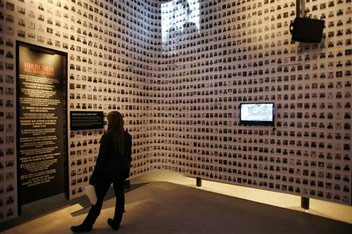
|  |  |  News Around the Republic of Mexico News Around the Republic of Mexico  
New Museum Brings Lessons of Genocide to Mexico
 Molly O'Toole & Alexandra Olson - Associated Press Molly O'Toole & Alexandra Olson - Associated Press
go to original
October 12, 2010


| | In this photo taken Oct. 6, 2010, a woman looks at pictures of Cambodia's genocide victim displayed at the Memory and Tolerance Museum in Mexico City. (AP/Miguel Tovar) |  |
Mexico City — A new museum is bringing the lessons of the Holocaust and its grim cousins to new generations of Mexicans - and reminding them the intolerance that feeds genocide can even grow close to home.

The five-story glass and concrete building inaugurated Monday beside Mexico's Foreign Relations Department takes visitors through chilling displays on the Nazi Holocaust and how it was seen from Mexico, then continues through other horrors, including the slaughters of Armenians, Tutsis and Sudanese.

It moves toward the very borders of Mexico as well: the 36-year civil war in neighboring Guatemala, where government forces exterminated scores of Mayan Indian villages during a bloodbath that cost some 200,000 lives and drove thousands of refugees into Mexico.

"It's important as a nation to be very vigilant about any act of exclusion," said President Felipe Calderon during the inauguration. "We have not overcome discrimination, which affects many groups of society - indigenous people, women, children, people with disabilities and migrants."

Genocide survivors from Rwanda to Yugoslavia attended the opening, which featured tours of the exhibits and a reception in the cavernous wood and concrete main hall.

Vjollca Bajraj, who came to Mexico as a refugee after fleeing ethnic cleansing in Kosovo in 1999, cried when she saw images of Albanians being expelled from their land. At least 6,000 were killed and 1.5 million driven out by Serbians, according the U.S. State Department.

"I'm very moved that a country so far from my home has a representation of the pain I suffered," Bajraj said, adding that 54 members of her family were killed. "Mexico is a tolerant place, though there's still a lot to be done here, like in the rest of the world."

The 75,300-square-foot (7,000-square-meter) museum, a decade in the making, is the dream of Sharon Zaga, whose grandmother moved to Mexico from Czechoslovakia as World War II broke out and whose great-aunt survived Auschwitz.

At 15, she declared during a career day at school that she would build a museum dedicated to the Holocaust and began pursuing that goal in her early 20s, taking university courses on genocide and making connections among some 250 Holocaust survivors in Mexico and their descendants.

In 1999, a group founded a nonprofit organization - Memoria y Tolerancia - which began collecting donations and material for the museum, whose funding almost entirely comes from private individuals, many of them Jewish.

Mexican artists donated their time, including architect Ricardo Legorreta who designed the white building overlooking the tree-shaded Alameda park.

A quarter of the museum's original objects come from individuals, including spoons and forks used in concentration camps. Poland sent a railroad boxcar once used to transport Jewish prisoners to death camps.

Zaga, 34, visited other Holocaust museums around the world and decided the Mexico museum would have a special focus on bringing the effects of prejudice and intolerance home to Latin Americans, who sometimes see the U.S.-backed war in Guatemala as a thing apart from widely recognized crimes against humanity like the Holocaust, the Rwanda massacres and the brutal Khmer Rouge regime in Cambodia.

A dark wall with hundreds of protruding nails provides the background for the exhibit on Guatemala - the nails symbolizing the coffins built during the war.

A screen shows footage of Mayan men lowering child-sized coffins into graves, of an excavated grave with a skeleton intertwined with brightly colored Mayan attire, of an elderly Mayan woman on her knees, praying, surrounded by soldiers.

Visitors are confronted as well with the sorts of scenes they might see leaving the museum itself: the discrimination and poverty faced by indigenous people in Mexico, of Indian children juggling on street corners, of the elderly begging on the streets.

Francisco Chavez, a human rights worker who came from Guatemala for the opening, saw images of his mother and grandmother in photographs of the dead.

"We were surprised. We didn't know we were going to find an exhibit like this," said Chavez of the Association for Truth and Reconciliation in Guatemala, where no top military leaders have been prosecuted for the atrocities. "It motivates us to keep going to achieve the justice we've been seeking in Guatemala."

Associated Press Writer Juan Carlos Llorca in Guatemala City contributed to this story.
|

 |
|  |



